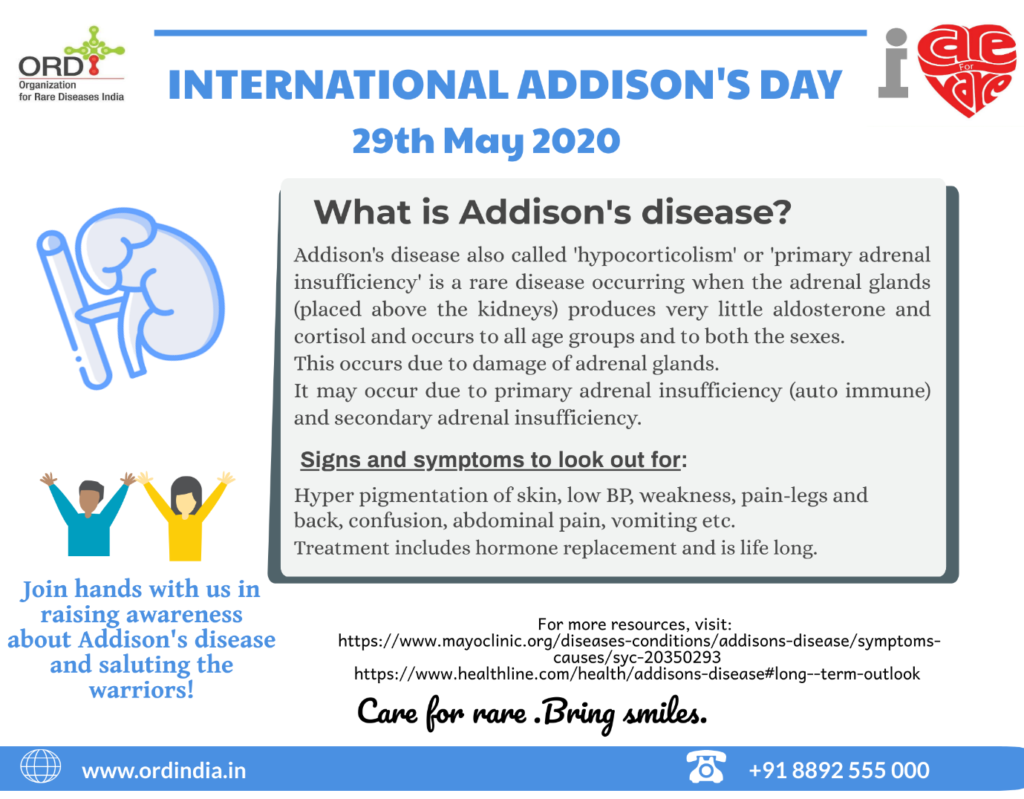Addison’s disease
Addison’s disease, or hypercortisolism is a rare disorder which occurs due to the insufficient production of the steroid hormones-aldosterone and cortisol by the outer two layers of cells present in the adrenal gland. This disease can affect all age groups and both sexes.
Figure 1: Addison’s disease
Symptoms:
Common signs and symptoms observed for adrenal insufficiency are as follows:
- Extreme tiredness
- Loss of appetite and weight loss
- Hyperpigmentation of skin (darkening) on knuckles, elbows, toes, lips
- Weakened muscles, joint pain and abdominal pain
- Low blood pressure and low blood glucose condition (Hypoglycemia)
- Behavioral symptoms-depression, irritation, craving for salty foods
- Gastrointestinal problems-nausea, vomiting, diarrhea
Figure 2: Signs and symptoms of Addison’s disease
Cause:
The damage to the adrenal glands is the main cause of Addison’s disease. When the gland is damaged, it does not release sufficient amount of cortisol or aldosterone which cause this disease. This can be classified into two types as follows-
- Primary adrenal insufficiency-here cortex is damaged and the body fails to release enough adrenocortical hormones and further leads to the body attacking itself (auto immune). Lack of proper functioning of adrenal gland also leads to tuberculosis, spread of cancer in the gland, infections causing bleeding into the glands.
- Secondary adrenal insufficiency– absence of adrenocorticotropic hormone in the body leads to lack of sufficient production of cortisol. The ACTH hormone produced in the pituitary gland controls the production of cortisol. Hence, if ACTH is not produced, this further hinders production of cortisol further causing Addison’s disease.
Affected population:
It affects males and females of any age groups. Around 40-60 people per million of the population are known to be affected by this disease. In India, it is known to affect 1 in 100,000 people.
Diagnosis:
The following tests are followed to diagnose Addison’s disease-
- Blood test: used to check the blood levels of sodium, potassium, cortisol and ACTH and also quantify antibodies related to the disease.
- Insulin-induced hypoglycaemia test: used to check blood sugar and cortisol level after administering an injection of insulin, test is suggested for the patient suffering from secondary adrenal insufficiency.
- ACTH stimulation test: in this test, the level of cortisol in the blood is measured before and after an injection of synthetic ACTH.
- Imaging tests: CT scan of abdomen is performed for detection of any abnormalities in the size of adrenal glands. MRI scan is also done on the pituitary gland if the patient is detected for secondary adrenal insufficiency.
Treatments:
Addison’s disease is mostly treated by hormone replacement therapy, where cortisol is often replaced by hydrocortisone, a corticosteroid which is consumed orally. Doctors also prescribe dexamethasone or prednisone. Aldosterone is replaced by fludrocortisone.
In some individuals, androgen replacement therapy is performed with androstenedione or testosterone hormone.
Doctors also recommend proper diet with more salt in case of heavy exercises or diarrhea.
We appreciate the efforts of Ms. Panchami.P, and Ms. Anandi Shivaram, MSc. BMG, VIT, Vellore in curating the content for Addison’s disease.
References:
http://• https://rarediseases.org/rare-diseases/addisons-disease/
http://• https://www.healthline.com/health/addisons-disease
Last updated: 25th June 2021





